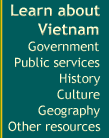After national reunification (1975), Vietnamese public health faced
countless difficulties: almost all
hospitals and medical units had been destroyed, epidemics were rampant, as
were social diseases
and drug addiction in South Vietnam, etc. Mobilizing the force of the
people and the assistance of
humanitarian organizations and of WHO, the Vietnamese government
determined to construct one
50- to- 100- bed health center in each district, one or more 300- to- 500-
bed hospitals in each
province and one health station in each commune. This does not include the
thousands of private
surgeries all over the country.
Medical and pharmaceutical colleges, training centers for medical
workers have been consolidated
and expanded.
In particular, therapy by traditional Oriental medicine, acupuncture
and acupressure, the practice of
exercising to care for one's health, therapeutic exercises, etc., are
being encouraged. The
campaigns for family planning, against AIDS, the controls of drug
addiction have been paid due
attention by the State and society.
The Health Ministry is carrying out, throughout the country, a campaign
to use iodized salt, a
vaccination program against six diseases and the supply of vitamin A to
children.
In the face of economic difficulties, the Vietnamese Government has
decided to increase the
number of the beneficiaries of free medical charges for poor households
and those in mountainous
areas, to enhance malaria control, to extend the aid to purchase medical
insurance for poor families,
war invalids and soldiers. The State has attached great importance to
primary health care for the
community.
Learn about Vietnam
Government |
Public services |
History |
Culture |
Geography |
Other resources











